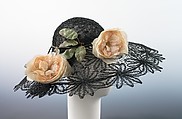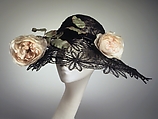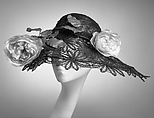Picture hat
Designer Sally Victor American
Not on view
During the 1930s, '40s and the early '50s, when hats were considered required accessories for well-dressed women, Sally Victor was among the foremost American milliners. Creative and very successful for almost 40 years, Victor began her prolific millinery career in 1927. She was one of the original members of the Edward C. Blum Design Laboratory, and often used the Brooklyn Museum's varied collections to draw inspiration for her designs. She was so connected with the Design Lab that she participated in several collaborative exhibitions and the museum often used her designs in publicity materials to exemplify how the Lab could benefit designers by providing inspiration. Her work is characterized by a special quirkiness that could often be traced back to interesting sources such as Native American tribes, the artist Henri Matisse or Japanese armor. She also combined traditional hat-making materials such as felt and silk with new synthetic materials in unique ways. According to her May 16, 1977 obituary in the "New York Times," Victor described her mission simply as "designing pretty hats that make women look prettier."
In this flirtatious design, Victor pulls from the large, broad-brimmed hats of the early decades of the 20th century. Usually decorated with delicate, feminine flowers, like this interpretation, the hats allowed the wearer to seductively peak under the brim. Victor was known for her inventive use of materials, and in this example she invents an unusual new form of lace, using straw as the ground and horsehair braid as the floral motifs. The sumptuous flower decorations are particularly refined and beautiful as well, which combined with the lace, create an overall stylish and charming hat.
This image cannot be enlarged, viewed at full screen, or downloaded.
This artwork is meant to be viewed from right to left. Scroll left to view more.




